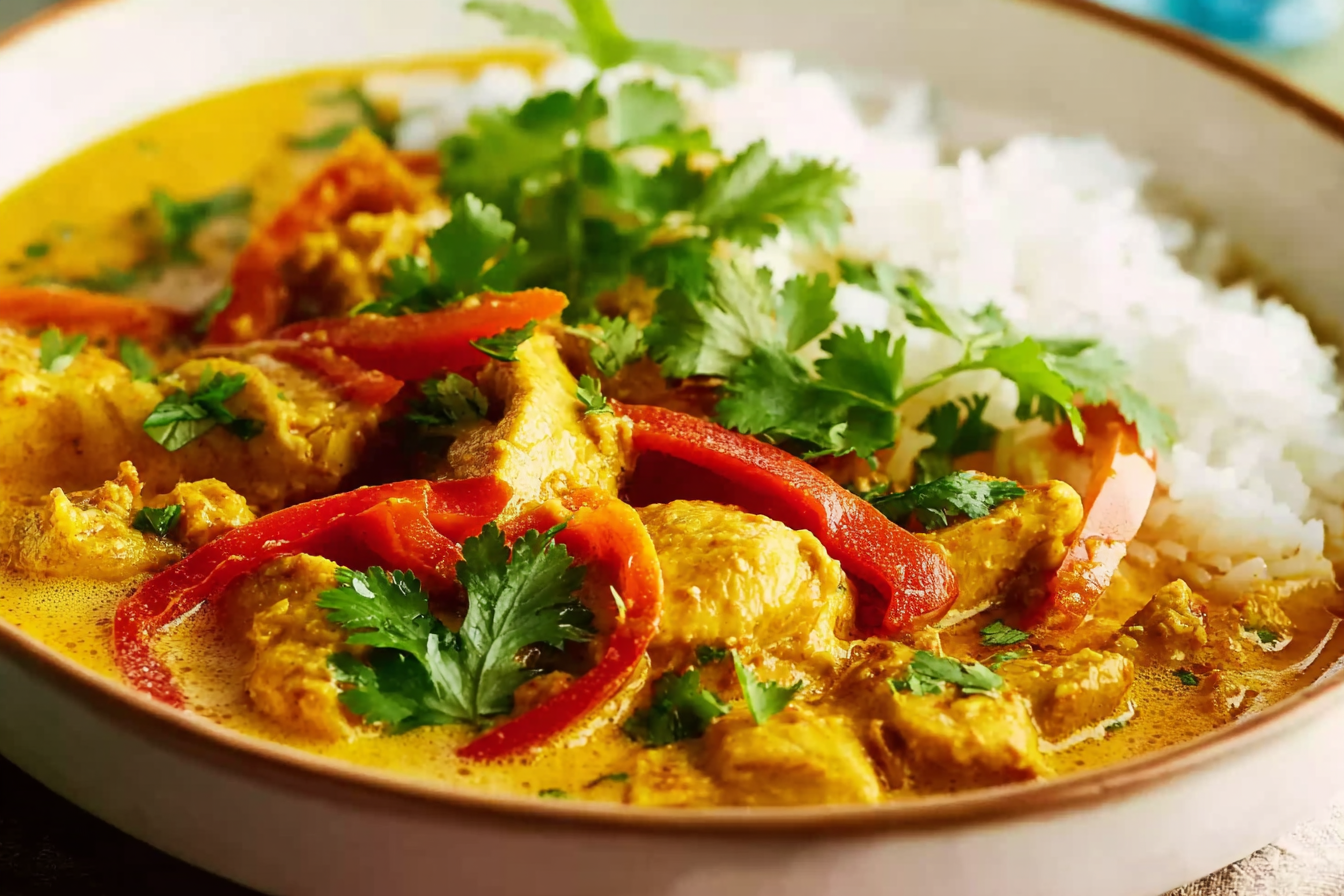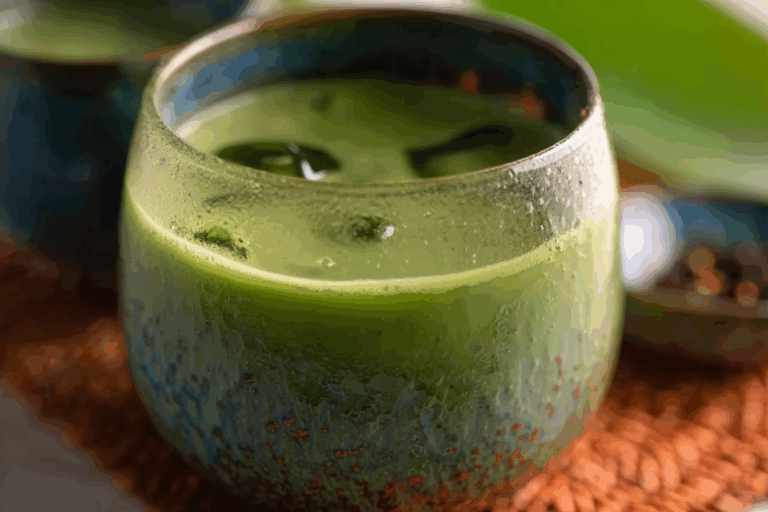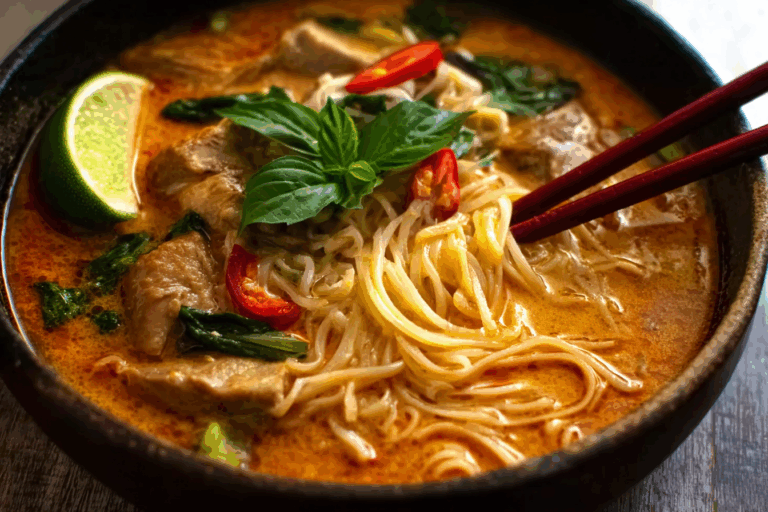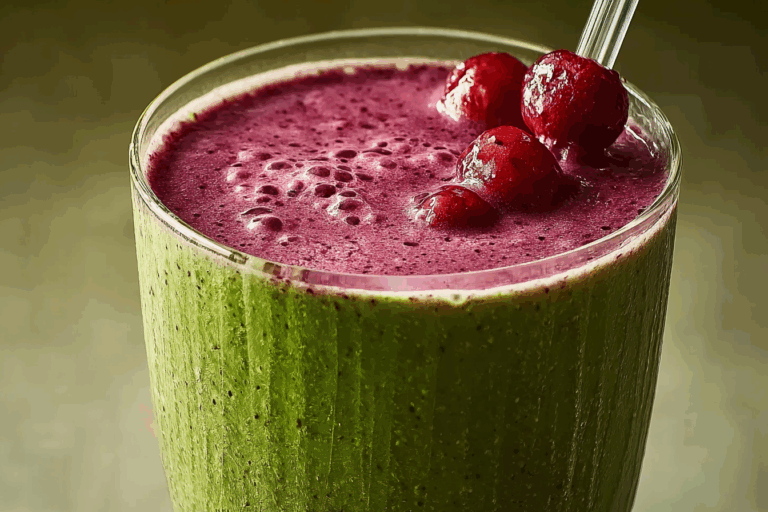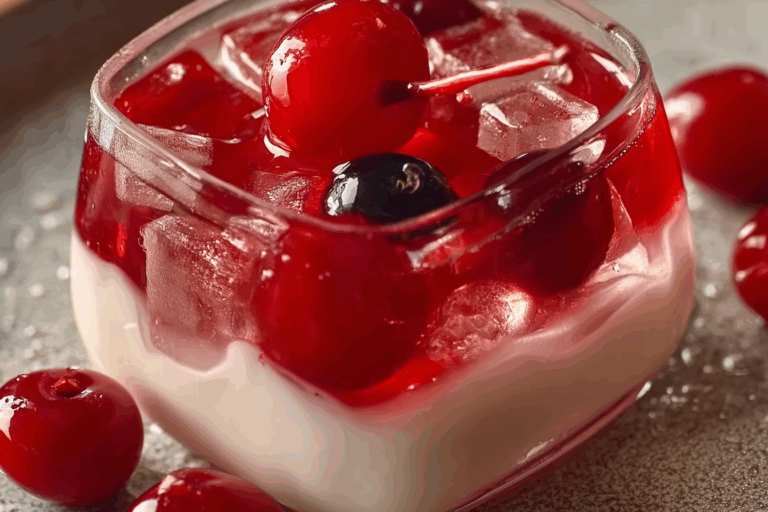Coconut Mango Chicken Curry Is the Creamy Thai-Inspired Dish: Learn How To Make It
Coconut Mango Chicken Curry isn’t just a meal; it’s a vibrant experience for your senses. At JustThaiRecipes, this dish reflects exactly what inspired Lina and her partner to create the blog. As shared in the About page, their journey began with a passion for Thai flavors and a mission to help home cooks worldwide replicate the magic of Thai cuisine. Every recipe they share, from spicy curries to delicate desserts, is crafted with the goal of bringing joy and authenticity to your table.
Now, imagine tender pieces of chicken sautéed with garlic and peppers, infused with the warmth of Thai yellow curry paste, sweetened naturally with juicy mango chunks, and enveloped in creamy coconut milk. It’s not just food—it’s comfort, culture, and celebration all in one bowl. In this article, we’ll take you step by step through how to make Coconut Mango Chicken Curry, explore why it’s so beloved in Thai and South Indian kitchens, offer healthy tweaks, answer your most-asked questions, and give tips for storing, reheating, and serving it like a pro.
This isn’t just another mango chicken curry recipe Jamie Oliver fans rave about. It’s an authentic Thai-inspired delight you’ll come back to every week.
Learn more about Thai Green Chicken Curry for another crowd-pleaser
Table of Contents
Table of Contents
Why Coconut Mango Chicken Curry Is a Must-Try
The Unique Flavor Combination of Coconut Mango Chicken Curry
What makes Coconut Mango Chicken Curry so irresistible? It’s the perfect trifecta of sweet, spicy, and creamy that balances your taste buds like few dishes can. Sweet mango chunks melt into the curry, adding a natural fruity richness. Coconut milk creates a velvety sauce that coats tender chicken pieces, while Thai yellow curry paste infuses just enough heat to keep things exciting without overpowering the other flavors.
This dish embodies the essence of Thai cooking—harmony of flavors and textures. It’s no surprise that easy coconut mango chicken curry recipes are gaining traction across the globe, from family kitchens in the USA to high-end restaurants serving Thai mango chicken curry with jasmine rice.
Cultural Roots: Thai and South Indian Influences
While Coconut Mango Chicken Curry is popularized as Thai, its roots stretch across South and Southeast Asia. In Thailand, curries are a staple, with coconut milk and curry paste forming the base of countless dishes. Mango, often used in desserts like mango sticky rice, finds a savory home in this curry, creating a signature sweet-heat balance.
Meanwhile, in South India, chicken mango curry Indian style offers a spicier, tangier twist with additional spices like cardamom, clove, and sometimes tamarind. Both versions showcase how this ingredient pairing transcends borders to become a beloved comfort food.
If you’ve ever wondered, “Can you put mango in chicken curry?” the answer is a resounding yes, as proven by variations like coconut mango chicken curry Indian style and creamy mango chicken recipes served in Thai-inspired restaurants.
Why It’s Perfect for Every Occasion
Whether you’re hosting a dinner party or looking for a quick weeknight meal, this dish fits the bill. It’s easy to prepare, adaptable for different spice levels, and pairs beautifully with jasmine rice, naan, or even cauliflower rice for a low-carb option.
It’s also an excellent make-ahead dish. The flavors deepen overnight, making it perfect for meal prep or next-day leftovers. With simple swaps, like using rotisserie chicken or light coconut milk, you can tailor this easy coconut mango chicken curry to your preferences.
Discover great ideas like our Cashew Chicken Thai Style
Ingredients Breakdown for Coconut Mango Chicken Curry
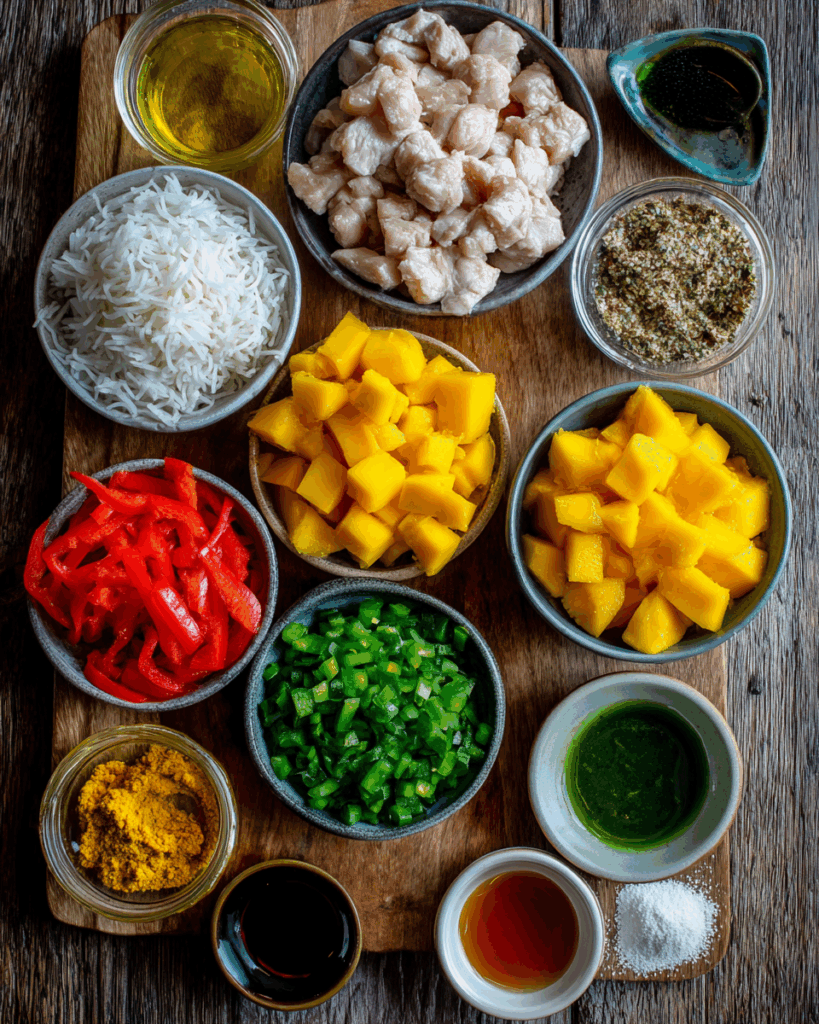
Essential Ingredients and Why They Matter
Cooking Coconut Mango Chicken Curry starts with a handful of fresh, flavorful ingredients that come together to create an unforgettable dish. Each ingredient plays a unique role, from adding depth and aroma to building the creamy, tropical base this curry is famous for. Let’s break them down:
Sesame Oil (3 tbsp, divided 2:1)
Sesame oil is more than just a cooking medium; it adds a subtle nutty aroma to your coconut mango chicken curry coconut milk base. You can substitute it with peanut oil for a stronger nutty flavor, perfect for those who enjoy a richer undertone.
Chicken Breast (3, cubed/diced)
Lean and tender, chicken breast absorbs the curry sauce beautifully. If you prefer a juicier texture, opt for boneless chicken thighs. This creamy mango chicken recipe is highly forgiving, making it easy to swap based on your preferences.
Yellow Onion (½ cup, diced)
Onions form the flavor foundation. As they caramelize, they release natural sweetness that enhances the fruity notes of mango and balances the heat from curry paste.
Red and Green Bell Peppers (1 large each, julienned)
These peppers add a crunch and vibrant color, turning your Thai mango chicken curry into a visually stunning dish. Red bell peppers bring mild sweetness, while green ones offer a slightly bitter edge for contrast.
Aromatics and Flavor Enhancers
Garlic (3 cloves, minced or grated)
Garlic’s pungent, earthy flavor cuts through the sweetness and creaminess, grounding the dish. Grating it ensures an even distribution throughout the sauce.
Yellow Curry Paste (2 tbsp, Thai)
This paste is the soul of the dish, delivering a complex blend of spices like turmeric, cumin, and lemongrass. Its warmth transforms the coconut mango chicken curry Indian variations into a Southeast Asian delight.
Ground Ginger (½-¾ tsp)
A hint of ginger complements the curry’s heat while harmonizing with the tropical notes of mango and coconut milk.
Fish Sauce (1½ tsp)
Fish sauce introduces umami depth that ties the flavors together. If you prefer vegetarian alternatives, try soy sauce or tamari.
Liquids and Sweetness
Chicken Broth (1 cup)
Chicken broth lightens the curry sauce and helps it simmer into a rich consistency. For a vegetarian option, vegetable broth works just as well.
Frozen Mango Chunks (3 cups)
Mango is the star ingredient. Using frozen chunks keeps prep simple while ensuring you get that luscious, fruity sweetness. For mango chicken curry South Indian style, fresh mango can be used for a stronger punch.
Coconut Milk (2 cups, divided 1:1)
Coconut milk gives the curry its creamy body and slightly sweet flavor. Full-fat coconut milk is ideal for a richer texture, but light coconut milk works if you’re watching calories.
Fresh Herbs and Accompaniments
Cilantro (¼ cup plus more for garnish)
Fresh cilantro adds brightness and a touch of peppery freshness. Sprinkle generously just before serving.
Cooked Jasmine Rice
This soft, fragrant rice is the perfect partner to creamy mango chicken curry recipes. Its neutral flavor allows the curry sauce to shine.
Ingredient Substitutions for Dietary Preferences
- Swap chicken with tofu or chickpeas for a vegetarian version.
- Use cauliflower rice instead of jasmine rice for a low-carb alternative.
- Replace fish sauce with soy sauce for vegan-friendly adjustments.
These small tweaks make the coconut mango chicken curry recipe Jamie Oliver fans adore even more versatile for modern diets.
Step-by-Step Guide to Cooking Coconut Mango Chicken Curry

Preparing the Ingredients: Mise en Place
Before turning on the stove, it’s essential to have all your ingredients prepped and ready. Dice the chicken breast into bite-sized cubes, ensuring even cooking. Julienne the bell peppers for a beautiful presentation, and mince the garlic finely to allow it to infuse the curry sauce with its robust aroma. Having frozen mango chunks thawed slightly helps them blend seamlessly into the dish.
Pro Tip: For a truly creamy mango chicken recipe, use fresh mangoes when in season for their vibrant flavor and velvety texture.
Cooking the Chicken
- Heat your wok or a large skillet over high heat. Add 2 tablespoons of sesame oil and swirl to coat.
- Place the cubed chicken breast in the hot oil. Let it sear undisturbed for 2-3 minutes to develop a slight golden crust. Stir occasionally and cook until the chicken is almost done (about 5-6 minutes).
- Remove the chicken from the wok and set aside, reserving any juices.
Why this step matters: Browning the chicken at this stage locks in its juices and gives your coconut mango chicken curry Indian style a savory base note.
Sautéing Aromatics and Vegetables
- With the wok still hot, add the remaining 1 tablespoon of sesame oil.
- Toss in the diced yellow onions. Stir-fry for about 2 minutes until translucent and fragrant.
- Add the julienned red and green bell peppers and minced garlic. Continue stir-frying for 3-5 minutes until the vegetables are tender yet still crisp.
Pro Tip: Stir constantly to prevent the garlic from burning, which can introduce bitterness to your Thai mango chicken curry.
Building the Curry Sauce
- Add 2 tablespoons of yellow curry paste to the wok. Stir well to coat the vegetables.
- Sprinkle in ½-¾ teaspoon ground ginger and pour in 1½ teaspoons fish sauce.
- Slowly add 1 cup chicken broth, stirring constantly to fully dissolve the curry paste.
- Allow the mixture to come to a gentle simmer for 3 minutes. This helps reduce the liquid slightly and intensifies the flavors.
Pro Tip: For a spicier kick, incorporate a pinch of crushed red pepper flakes or Thai chilies at this stage.
Bringing It All Together
- Return the cooked chicken (with its juices) to the wok. Stir well to combine with the simmering curry sauce.
- Continue simmering for 2 more minutes to let the chicken absorb the flavors.
- Add 3 cups of mango chunks and ¼ cup chopped cilantro, stirring gently so as not to break the mango pieces. Cook for another 2 minutes, allowing the mango to soften and release its sweetness into the sauce.
Creating the Creamy Coconut Base
- Pour in 1 cup of coconut milk, increasing the heat slightly to bring it to a high simmer. Allow the curry to bubble for 3-5 minutes until it starts to thicken naturally.
- Once slightly reduced, add the remaining 1 cup of coconut milk. Return to a high simmer for an additional 2 minutes.
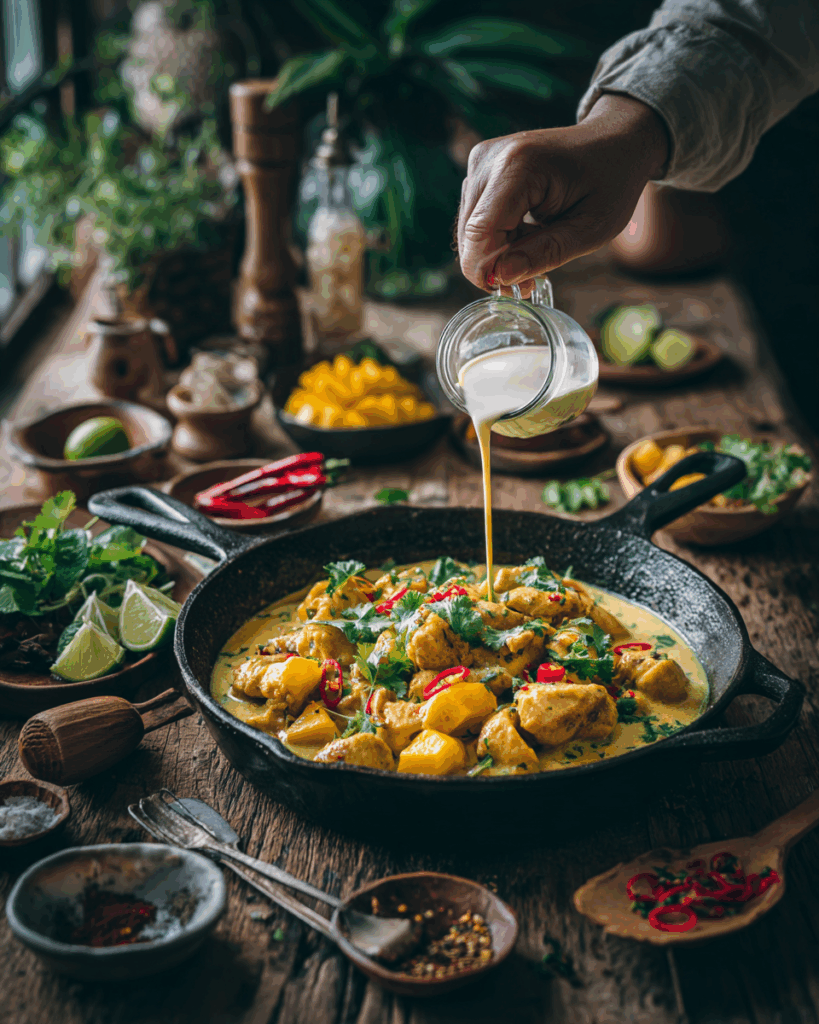
This two-step coconut milk addition gives the sauce a luscious, layered creaminess that makes easy coconut mango chicken curry recipes so addictive.
Serving Coconut Mango Chicken Curry Like a Pro
Serve the curry piping hot over fluffy jasmine rice. Garnish with fresh chopped cilantro and, if desired, a squeeze of lime for added brightness. Pair it with Thai cucumber salad or crispy papadum for an extra burst of texture and flavor.
Chef’s Tips for Perfect Results Every Time
- Use a heavy-bottomed pan if you don’t own a wok to prevent the coconut milk from scorching.
- For a low-carb version, replace jasmine rice with cauliflower rice.
- To make it dairy-free and vegan, substitute chicken with firm tofu and use soy sauce instead of fish sauce.
Variations of Coconut Mango Chicken Curry
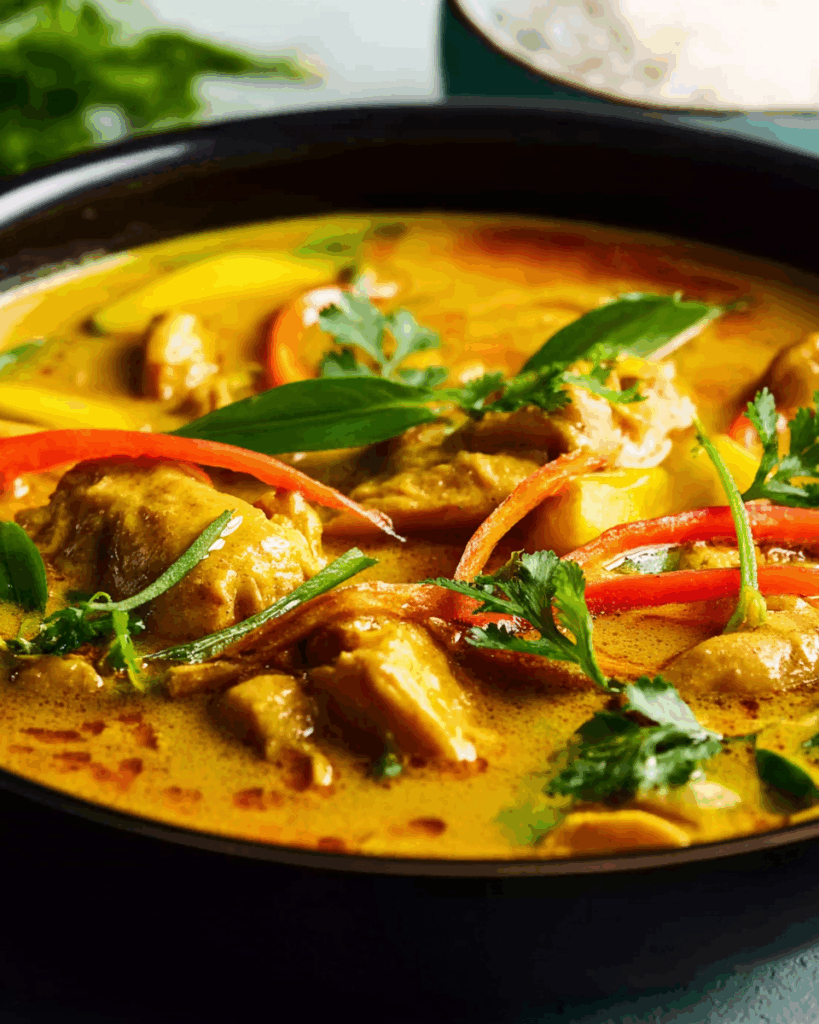
Thai Mango Chicken Curry vs South Indian Mango Chicken Curry
Coconut Mango Chicken Curry exists in different forms across Asia, each with its unique spin on this comforting dish.
In Thailand, the curry is lighter and creamier. It leans heavily on coconut milk and fragrant herbs like kaffir lime leaves and Thai basil. Sweet mango chunks balance out the heat from yellow curry paste, creating a mild yet flavorful experience. This version is perfect for those new to curry and looking for a gentle introduction to Thai cuisine.
Meanwhile, the South Indian mango chicken curry Indian style is bolder. It incorporates spices like cardamom, cinnamon, and clove, giving the sauce a more robust and earthy profile. Tamarind or yogurt is sometimes added for tanginess, which beautifully complements the sweetness of mango.
Want to explore other creamy mango chicken recipes? Check out this Creamiest Mango Chicken Coconut Curry from Nkechi Ajaeroh. It’s a healthy, gluten-free, dairy-free variation that’s perfect for weekday dinners.
Quick Hacks for Busy Weeknights
When you’re short on time but craving coconut mango chicken curry coconut milk flavors, there are a few hacks you can try:
- Use rotisserie chicken: Skip cooking raw chicken and stir shredded rotisserie chicken into the curry sauce during the final minutes.
- Canned mango puree: Substitute fresh or frozen mango chunks with canned puree for a smoother sauce and quicker prep.
- Instant Pot Method: Sauté aromatics and chicken directly in the Instant Pot, then pressure cook everything for just 6 minutes.
Customizing the Recipe for Dietary Preferences
Vegetarian and Vegan Options
Replace chicken with firm tofu or chickpeas for a plant-based version. Swap fish sauce with soy sauce or coconut aminos for a vegan-friendly alternative.
Low-Calorie Adjustments
- Use light coconut milk instead of full-fat.
- Serve over cauliflower rice instead of jasmine rice.
These small tweaks allow you to enjoy this creamy mango chicken recipe guilt-free while keeping all the tropical flavors intact.
Pairings Beyond Rice
Although jasmine rice is the traditional accompaniment, there are plenty of creative pairings:
- Quinoa or couscous for a protein-rich base.
- Roti or naan bread to scoop up the luscious curry sauce.
- Zucchini noodles (zoodles) for a light, low-carb option.
Coconut Mango Chicken Curry Healthy?
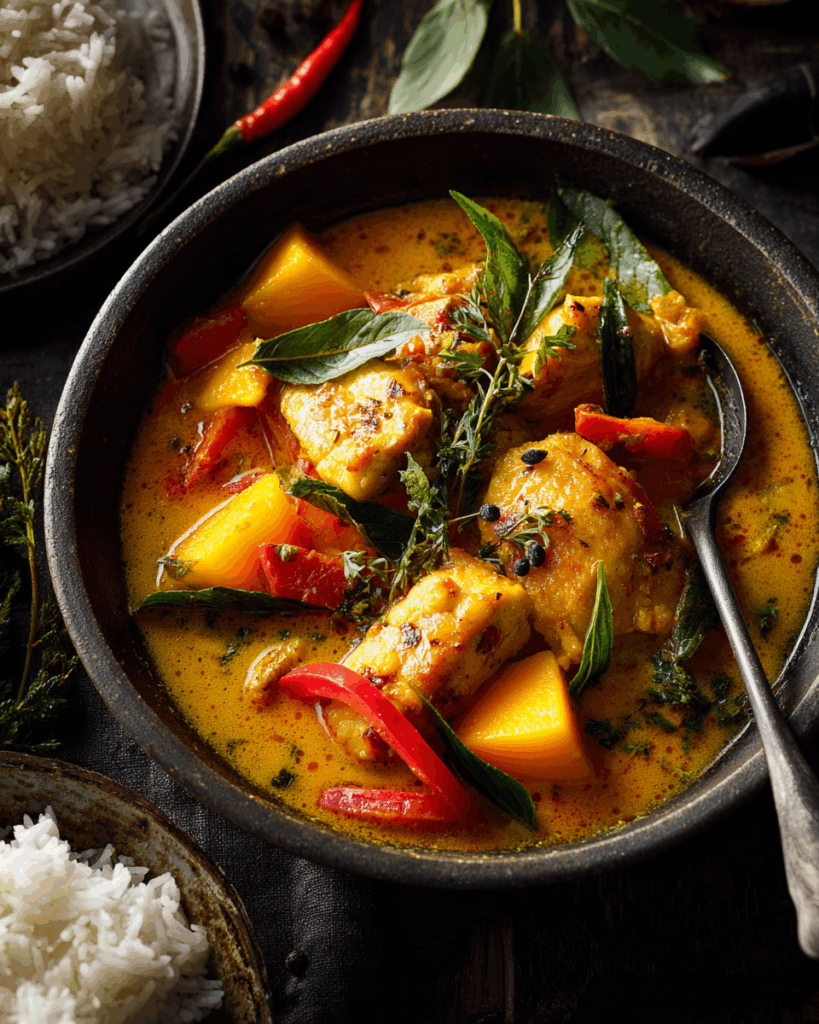
Nutritional Benefits of Coconut Mango Chicken Curry
Coconut Mango Chicken Curry isn’t just a delicious meal—it’s also packed with nutrients that make it a wholesome choice for lunch or dinner. Let’s break down why this dish is as good for your body as it is for your taste buds.
High in Protein
With lean chicken breast as its primary protein source, this curry delivers the essential amino acids your body needs for muscle repair, energy production, and overall wellness. One serving provides approximately 25–30 grams of high-quality protein.
Rich in Vitamins and Minerals
Mangoes are a powerhouse of vitamins A and C, both of which support immune health and skin vitality. Bell peppers also add a dose of antioxidants, particularly beta-carotene, which helps fight free radicals. Coconut milk contributes minerals like manganese, copper, and iron, all crucial for metabolic functions.
Heart-Healthy Fats
Though coconut milk contains saturated fats, it primarily provides medium-chain triglycerides (MCTs). These fats are metabolized quickly and can provide a steady source of energy. Paired with sesame oil, which is rich in monounsaturated fats, the curry strikes a balance between indulgence and nutrition.
Calorie and Macronutrient Breakdown
Here’s an approximate nutrition profile per serving of Coconut Mango Chicken Curry (without rice):
| Nutrient | Amount |
|---|---|
| Calories | 420 kcal |
| Protein | 27 g |
| Carbohydrates | 18 g |
| Sugars (Natural) | 12 g |
| Fat | 28 g |
| Saturated Fat | 16 g |
| Fiber | 3 g |
| Sodium | 740 mg |
Is Coconut Curry Chicken Healthy for Everyday Meals?
While Coconut Mango Chicken Curry is nutrient-dense, moderation is key due to its fat content from coconut milk. However, the fats present are largely healthy MCTs, which have been linked to improved metabolism and satiety.
If you’re aiming for a heart-healthy diet, consider using light coconut milk and reducing the amount slightly. Pairing the curry with a high-fiber side like brown rice or quinoa can also balance the meal.
This easy coconut mango chicken curry remains a great option for families, offering a satisfying yet nourishing alternative to takeout.
Healthy Swaps to Lighten Up the Dish
- Light Coconut Milk: Cuts calories and saturated fat without sacrificing creaminess.
- Cauliflower Rice: Replaces jasmine rice for a low-carb, keto-friendly version.
- Tofu or Chickpeas: Swap out chicken for plant-based proteins to create a vegan coconut mango chicken curry Indian version.
- Less Oil: Reduce sesame oil to 1 tablespoon total for stir-frying to lower the fat content further.
These adjustments make it possible to enjoy this creamy mango chicken recipe as part of your regular meal rotation without compromising your health goals.
Why Coconut Mango Chicken Curry Fits Into Balanced Diets
This dish hits multiple nutrition targets at once. It’s high in protein, offers complex carbohydrates from mangoes and vegetables, and provides healthy fats that keep you full longer. Plus, with its vibrant colors and bold flavors, it’s as good for the soul as it is for the body.
In short, Coconut Mango Chicken Curry is more than just an occasional treat—it can be part of a healthy, balanced diet with minimal tweaks.
Serving Suggestions and Pairings
Best Sides to Serve With Coconut Mango Chicken Curry
Coconut Mango Chicken Curry is an incredibly versatile dish, making it easy to pair with a variety of sides for a complete meal. Whether you prefer something traditional or are ready to experiment, there’s no shortage of options to complement its creamy, tropical flavors.
Steamed Jasmine Rice
This classic pairing allows the rich coconut mango sauce to shine. The light, fluffy texture of jasmine rice soaks up every drop of curry, making each bite irresistibly flavorful. For a touch of elegance, sprinkle finely chopped cilantro over the rice just before serving.
Basmati Rice with Aromatic Spices
For a subtle twist, serve the curry with basmati rice cooked with a pinch of cardamom and cinnamon. This Indian-inspired pairing enhances the coconut mango chicken curry Indian notes, adding warmth and fragrance to the meal.
Innovative Pairings for Modern Palates
Cauliflower Rice for Low-Carb Lovers
If you’re cutting carbs, cauliflower rice is an excellent alternative. It’s light, nutritious, and doesn’t overpower the creamy mango chicken recipe flavors. A quick sauté in a little sesame oil gives it a satisfying texture and taste.
Naan Bread or Roti
Perfect for scooping up the velvety curry sauce, naan bread and roti offer a comforting, hands-on eating experience. Lightly toast them for added crispness and brush with garlic butter for a flavor boost.
Zucchini Noodles (Zoodles)
For a gluten-free and low-calorie option, spiralized zucchini noodles bring a fresh, crunchy texture that pairs beautifully with the creamy coconut mango chicken curry coconut milk sauce.
Fresh and Vibrant Sides to Balance the Richness
Thai Cucumber Salad
This crisp, refreshing salad made with thinly sliced cucumbers, red onions, and a tangy lime dressing provides a cool counterpoint to the warm, creamy curry.
Mango Avocado Salsa
Enhance the tropical vibes with a side of mango avocado salsa. The sweet mango and creamy avocado echo the curry’s main flavors while adding a bright, citrusy kick.
Pickled Vegetables
Pickled carrots, radishes, or even kimchi add acidity and crunch, which cuts through the richness of the coconut milk and creates a delightful balance on the plate.
Beverages to Complement Coconut Mango Chicken Curry
Pairing your meal with the right drink can elevate the entire dining experience:
- Thai Iced Tea: Sweet and creamy with a hint of spice, it’s a perfect match for the curry’s heat.
- Coconut Water: Light and refreshing, it reinforces the tropical flavors of the dish.
- Chardonnay or Sauvignon Blanc: For a more formal meal, a chilled glass of white wine complements the curry’s richness beautifully.
Presentation Tips for a Restaurant-Quality Finish
Coconut Mango Chicken Curry isn’t just about taste—it’s also a visual feast. Here’s how to plate it like a pro:
- Serve the curry in shallow bowls over a bed of steaming rice for maximum appeal.
- Garnish generously with fresh cilantro leaves and a few thin slices of red chili for color.
- Place a lime wedge on the side for those who enjoy a zesty squeeze over their curry.
Why These Pairings Work
Each side and beverage recommendation enhances the core qualities of Coconut Mango Chicken Curry. Jasmine rice and naan soak up the luscious sauce. Salads and pickles bring contrast, keeping each bite exciting. Meanwhile, drinks like Thai iced tea and coconut water round out the tropical theme of the meal.
Storing and Reheating Coconut Mango Chicken Curry
How to Store Leftover Coconut Mango Chicken Curry Properly
Coconut Mango Chicken Curry makes fantastic leftovers because the flavors deepen over time, creating an even more satisfying meal the next day. However, proper storage is key to maintaining its creamy texture and fresh taste.
Refrigeration
Allow the curry to cool completely before transferring it into airtight containers. This step prevents condensation, which can water down the sauce. Store in the refrigerator for up to 4 days.
Pro Tip: Use shallow containers to help the curry cool faster and avoid potential bacterial growth.
Can You Freeze Coconut Mango Chicken Curry?
Yes, this dish freezes beautifully. Freezing is an excellent option if you’ve made a large batch or want to prep meals in advance.
Freezing Instructions
- Portion the cooled curry into freezer-safe containers or resealable freezer bags.
- Leave a little space at the top of containers for expansion as the sauce freezes.
- Store in the freezer for up to 3 months.
Pro Tip: Label containers with the date so you can track freshness.
When to Avoid Freezing
While coconut milk freezes well, the texture may become slightly grainy after thawing. To minimize this, stir the curry thoroughly during reheating. For best results, avoid freezing if you’ve already used light coconut milk, as it’s more prone to separation.
Best Way to Reheat Coconut Mango Chicken Curry
Reheating this creamy mango chicken recipe correctly ensures the sauce remains velvety and the chicken stays tender.
On the Stovetop
- Transfer the curry to a saucepan and set over medium-low heat.
- Add a splash of coconut milk or chicken broth to loosen the sauce if it has thickened in storage.
- Stir gently and heat until warmed through, about 5–7 minutes.
This method helps the curry retain its original texture and flavor.
In the Microwave
- Place a portion of the curry in a microwave-safe bowl.
- Cover loosely with a microwave-safe lid or plate to prevent splatters.
- Heat on medium power in 1-minute intervals, stirring between each, until hot.
Pro Tip: Avoid using high heat as it can cause the coconut milk to separate.
Can You Reheat Coconut Mango Chicken Curry Multiple Times?
For food safety and quality, it’s best to reheat only the portion you plan to eat. Repeated reheating can dry out the chicken and affect the curry’s creamy consistency.
Tips for Making Leftovers Feel Like a Fresh Meal
- Serve over freshly cooked jasmine rice or try a new base like quinoa or couscous.
- Add a handful of fresh cilantro and a squeeze of lime just before serving to revive flavors.
- Stir in a few extra mango chunks for added sweetness and texture.
Common Mistakes to Avoid When Making Coconut Mango Chicken Curry
Even seasoned cooks can run into challenges when preparing Coconut Mango Chicken Curry. From ingredient missteps to technique errors, knowing what to watch out for can mean the difference between a good curry and an unforgettable one. Let’s break down the most common mistakes and how to avoid them.
1. Overcooking the Chicken
Why It Happens
Since chicken breast cooks quickly, it’s easy to leave it in the pan too long, resulting in a dry, rubbery texture.
How to Fix It
Cook the chicken just until it turns opaque and is no longer pink in the center, then remove it from the pan while you prepare the sauce. Return it only during the final minutes to finish cooking in the curry sauce. This technique locks in moisture, ensuring tender, juicy pieces in every bite.
Pro Tip: For an even juicier version, try using boneless chicken thighs, which are more forgiving to slight overcooking.
2. Using the Wrong Coconut Milk
Why It Matters
Not all coconut milk is created equal. Using sweetened coconut milk or coconut cream instead of unsweetened full-fat coconut milk can drastically change the flavor and consistency of your curry.
Best Practice
Always choose unsweetened, full-fat coconut milk for the richest, creamiest results. Light coconut milk works for a lower-calorie version, but keep in mind it may make the sauce slightly thinner.
3. Skipping the Mango or Using Unripe Mango
Why It’s a Problem
Mango isn’t just a garnish in coconut mango chicken curry coconut milk recipes—it’s a star ingredient. Using mangoes that aren’t ripe enough leads to a lack of sweetness and a fibrous texture in the sauce.
Solution
Choose ripe, slightly soft mangoes for fresh recipes, or rely on high-quality frozen mango chunks for convenience. Both options ensure your curry has the perfect balance of sweetness and creaminess.
4. Burning the Curry Paste
Common Cause
Adding curry paste directly to a hot pan without enough oil or liquid can lead to scorching, which gives the entire dish a bitter undertone.
Prevention
Sauté the curry paste gently in oil for 30–60 seconds before adding liquids. Stir constantly and watch for its aroma to bloom, which signals it’s ready for the next step.
5. Over-Thickening or Thinning the Sauce
What Goes Wrong
Simmering too long can cause the coconut milk to reduce excessively, creating a too-thick, almost pudding-like texture. On the flip side, adding too much broth or coconut milk at once can leave the sauce runny.
How to Balance It
Simmer the sauce gently and keep an eye on consistency. If it gets too thick, add a splash of chicken broth. If too thin, let it reduce uncovered for a few extra minutes.
6. Forgetting to Adjust Seasoning
Why It Matters
The flavor of Coconut Mango Chicken Curry depends on balancing sweetness, saltiness, and spice. Without tasting and adjusting, your curry may lean too far in one direction.
Pro Tip
Before serving, taste the curry and adjust with a pinch of salt, a dash of lime juice for acidity, or even a tiny drizzle of honey if your mango wasn’t as sweet as expected.
Why Avoiding These Mistakes Matters
Perfecting these small details transforms your easy coconut mango chicken curry into a restaurant-quality dish. Not only will the flavors sing in harmony, but the creamy mango chicken recipe will also showcase a flawless texture and color, impressing anyone lucky enough to sit at your table.
Conclusion: Your Next Thai-Inspired Dinner Star
Coconut Mango Chicken Curry is more than just a recipe—it’s a celebration of flavors, colors, and textures that brings the vibrancy of Thai cuisine to your table. The combination of tender chicken, sweet ripe mango, aromatic spices, and creamy coconut milk creates a dish that’s both comforting and exciting.
Whether you’re cooking it for a cozy family dinner or impressing guests at a dinner party, this creamy mango chicken recipe is guaranteed to become a favorite in your kitchen. With its versatility, healthy potential, and irresistible taste, why not make Coconut Mango Chicken Curry your go-to dish for any occasion?
So grab your wok, gather those tropical ingredients, and create a bowl of deliciousness that transports you straight to the heart of Southeast Asia—one spoonful at a time.
FAQs About Coconut Mango Chicken Curry
Is coconut curry chicken healthy?
Coconut curry chicken can be a nutritious option when prepared thoughtfully. The dish provides lean protein from chicken, healthy fats from coconut milk, and vitamins from mangoes and bell peppers. Medium-chain triglycerides (MCTs) in coconut milk are a beneficial type of fat that your body uses quickly for energy. To make a lighter version, you can use light coconut milk and serve the curry with cauliflower rice instead of jasmine rice. These adjustments reduce calories while maintaining the creamy, flavorful experience that makes this creamy mango chicken recipe so irresistible.
Do chicken and mango go together?
Absolutely. Chicken and mango are a classic flavor pairing in many global cuisines, from Thai mango chicken curry to mango chicken curry South Indian versions. The mild taste of chicken allows the vibrant, fruity sweetness of mango to shine, while spices and coconut milk create a balanced, multi-layered flavor profile. This combination appeals to both sweet and savory palates, making it a favorite for family dinners and special occasions alike.
Can you put mango in chicken curry?
Yes, mango is a fantastic addition to chicken curry. Its natural sweetness balances out the heat and spices of the curry, while its soft texture melts slightly into the sauce, creating a luxurious, fruity base. Whether you’re making coconut mango chicken curry Indian style or a Thai variation, ripe mango or high-quality frozen chunks work equally well. For an extra tropical twist, blend part of the mango into a puree before adding it to the curry for a smoother, richer sauce.
How to make mango and coconut chicken?
Making mango and coconut chicken is surprisingly easy and requires only a few key steps. Start by searing diced chicken breast in sesame oil until almost cooked through. Set the chicken aside and sauté onions, bell peppers, and garlic in the same pan. Stir in yellow curry paste, ground ginger, and fish sauce before adding chicken broth to form the base of your sauce. Return the chicken to the pan, then add mango chunks and cilantro, letting the mango infuse sweetness into the dish. Finally, pour in coconut milk in two stages, simmering until the curry thickens to a creamy consistency. Serve hot with jasmine rice or roti for a complete meal.

